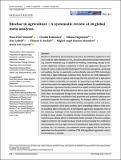Por favor, use este identificador para citar o enlazar a este item:
http://hdl.handle.net/10261/263150COMPARTIR / EXPORTAR:
 SHARE
BASE SHARE
BASE
|
|
| Visualizar otros formatos: MARC | Dublin Core | RDF | ORE | MODS | METS | DIDL | DATACITE | |

| Título: | Biochar in agriculture – A systematic review of 26 global meta-analyses |
Autor: | Schmidt, Hans-Peter; Kammann, Claudia; Hagemann, Nikolas; Leifeld, Jens; Bucheli, Thomas D; Sánchez-Monedero, Miguel Ángel CSIC ORCID ; Cayuela, María Luz CSIC ORCID | Palabras clave: | Anthropogenic dark earth (ADE) Biochar-based fertilization Climate change adaptation Greenhouse gas emissions Negative emission technology (NET) Pyrogenic carbon capture and storage (PyCCS) Soil organic carbon |
Fecha de publicación: | 1-sep-2021 | Editor: | John Wiley & Sons | Citación: | Global Change Biology Bioenergy 13(11): 1708-1730 (2021) | Resumen: | Biochar is obtained by pyrolyzing biomass and is, by definition, applied in a way that avoids its rapid oxidation to CO. Its use in agriculture includes animal feeding, manure treatment (e.g. as additive for bedding, composting, storage or anaerobic digestion), fertilizer component or direct soil application. Because the feedstock carbon is photosynthetically fixed CO from the atmosphere, producing and applying biochar is essentially a carbon dioxide removal (CDR) technology, which has a high-technology readiness level. However, for swift implementation of pyrogenic carbon capture and storage (PyCCS), biochar use in agriculture needs to deliver co-benefits, for example, by improving crop yields and ecosystem services and/or by improving climate change resilience by ameliorating key soil properties. Agronomic biochar research is a rapidly evolving field of research moving from less than 100 publications in 2010 to more than 15,000 by the end of 2020. Here, we summarize 26 rigorously selected meta-analyses published since 2016 that investigated a multitude of soil properties and agronomic performance parameters impacted by biochar application, for example, effects on yield, root biomass, water use efficiency, microbial activity, soil organic carbon and greenhouse gas emissions. All 26 meta-analyses show compelling evidence of the overall beneficial effect of biochar for all investigated agronomic parameters. One of the remaining challenges is the standardization of basic biochar analysis, still lacking in many studies. Incomplete biochar characterization increases uncertainty because adverse effects of individual studies included in the meta-analyses might be related to low-quality biochars, which would not qualify for certification and subsequent use (e.g. high content of contaminants, high salinity, incomplete pyrolysis, etc.). In summary, our systematic review suggests that biochar use in agriculture has the potential to combine CDR with significant agronomic and/or environmental co-benefits. | Versión del editor: | http://dx.doi.org/10.1111/gcbb.12889 | URI: | http://hdl.handle.net/10261/263150 | DOI: | 10.1111/gcbb.12889 | Identificadores: | doi: 10.1111/gcbb.12889 issn: 1757-1707 |
| Aparece en las colecciones: | (CEBAS) Artículos |
Ficheros en este ítem:
| Fichero | Descripción | Tamaño | Formato | |
|---|---|---|---|---|
| Schmidt2021GCBBioenergy.pdf | 532,99 kB | Adobe PDF |  Visualizar/Abrir |
CORE Recommender
Page view(s)
51
checked on 23-abr-2024
Download(s)
169
checked on 23-abr-2024
Google ScholarTM
Check
Altmetric
Altmetric
Este item está licenciado bajo una Licencia Creative Commons



